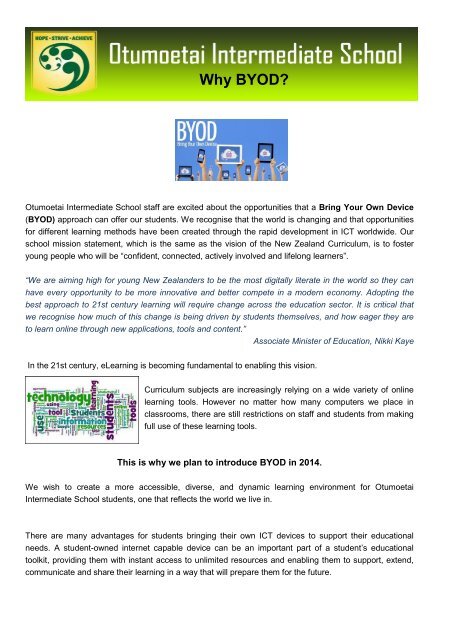Bring Your Own Devices - Otumoetai Intermediate School
Bring Your Own Devices - Otumoetai Intermediate School
Bring Your Own Devices - Otumoetai Intermediate School
Create successful ePaper yourself
Turn your PDF publications into a flip-book with our unique Google optimized e-Paper software.
Why BYOD?<br />
<strong>Otumoetai</strong> <strong>Intermediate</strong> <strong>School</strong> staff are excited about the opportunities that a <strong>Bring</strong> <strong>Your</strong> <strong>Own</strong> Device<br />
(BYOD) approach can offer our students. We recognise that the world is changing and that opportunities<br />
for different learning methods have been created through the rapid development in ICT worldwide. Our<br />
school mission statement, which is the same as the vision of the New Zealand Curriculum, is to foster<br />
young people who will be “confident, connected, actively involved and lifelong learners”.<br />
“We are aiming high for young New Zealanders to be the most digitally literate in the world so they can<br />
have every opportunity to be more innovative and better compete in a modern economy. Adopting the<br />
best approach to 21st century learning will require change across the education sector. It is critical that<br />
we recognise how much of this change is being driven by students themselves, and how eager they are<br />
to learn online through new applications, tools and content.”<br />
Associate Minister of Education, Nikki Kaye<br />
In the 21st century, eLearning is becoming fundamental to enabling this vision.<br />
Curriculum subjects are increasingly relying on a wide variety of online<br />
learning tools. However no matter how many computers we place in<br />
classrooms, there are still restrictions on staff and students from making<br />
full use of these learning tools.<br />
This is why we plan to introduce BYOD in 2014.<br />
We wish to create a more accessible, diverse, and dynamic learning environment for <strong>Otumoetai</strong><br />
<strong>Intermediate</strong> <strong>School</strong> students, one that reflects the world we live in.<br />
There are many advantages for students bringing their own ICT devices to support their educational<br />
needs. A student-owned internet capable device can be an important part of a student’s educational<br />
toolkit, providing them with instant access to unlimited resources and enabling them to support, extend,<br />
communicate and share their learning in a way that will prepare them for the future.
Some advantages of BYOD include:<br />
<br />
<br />
<br />
<br />
<br />
<br />
<br />
<br />
<br />
<br />
Anytime, anywhere access to class resources, support and extension activities through Google<br />
Apps for Education (this website is run through Google Sites).<br />
The ability to develop digital folders and work for their classes (that can’t be lost, are always<br />
accessible and never need replacing) through cloud computing.<br />
Being able to develop a portfolio of student learning using cloud applications.<br />
An increased ability to communicate and interact with teachers, parents and peers electronically to<br />
support their learning.<br />
Anytime, anywhere access to unlimited resources and information on the internet.<br />
The ability to draft, redraft and publish their work at the click of a button.<br />
Allowing students to become active partners in their learning.<br />
Enabling students to enter and explore new learning environments, overcoming barriers of distance<br />
and time, facilitate shared learning by enabling students to join or create communities of learners<br />
that extend well beyond the classroom.<br />
The creation of supportive differentiated learning environments by offering resources that take<br />
account of individual, cultural, or developmental differences.<br />
Enhancing opportunities to learn by offering students virtual experiences and tools that save them<br />
time and allowing them to take their learning further.<br />
WHAT WILL MY CHILD NEED?<br />
Not all students are in identical situations for BYOD.<br />
In 2014 <strong>Otumoetai</strong> <strong>Intermediate</strong> <strong>School</strong> will be recommending iPads or<br />
iPad minis to students who wish to bring their own device to school but this<br />
will not be mandatory and students will be able to bring any type of device<br />
that can assist them with their learning and meet our technical<br />
requirements.<br />
Strong evidence from other schools internationally suggests there are extremely good reasons for<br />
specifying a device for students to bring.<br />
1. Students will universally have a high quality digital learning experience<br />
2. Teachers will be able to accurately anticipate what students will or won't be able to do with their<br />
device.<br />
3. The school computer network can be optimally configured - rather than run with loose<br />
configurations that are appropriate for any device.
Technical Requirements<br />
Wireless Adapter<br />
Firstly, all students will need to connect to our network wirelessly. Wireless technology inside<br />
laptops, netbooks, tablets and smartphones has progressed considerably and modern devices are<br />
now using 'n' protocol technology. Although this is a little known fact, just one device on a school<br />
network using the older 'b' or 'g' technologies will slow ‘everyones' wireless experience - hundreds of<br />
other users.<br />
Of course, this is not acceptable and for this reason schools are demanding that all BYOD devices<br />
are 'n' capable or possibly even use the new 'ac' protocol. Our system will be able to accommodate<br />
the g technology and upwards but not the older b.<br />
Students will need to run Meraki Mobile Device Management software on their BYOD (including<br />
student laptops) devices to be able to connect to our wireless network.<br />
Meraki MDM will be deployed as part of the wireless sign up process.<br />
Meraki MDM will enable our support team to identify any devices that do not comply with our school<br />
student digital devices policies, such as Windows laptops not running Anti-Virus, any device running<br />
illegal or BitTorrent software. The software will also enable us to do a better job in providing<br />
technical support for BYOD.<br />
Note: The Meraki Device Management software has a built in wireless IP location tracking service.<br />
For those with privacy concerns, it may be possible to disable this service. However, the service can<br />
potentially be used to find, erase or even lock a device that has been stolen or misplaced. Our<br />
technical support will only utilise this feature, when directly requested by the owners of the device.<br />
All <strong>Devices</strong> need to be named in a way that easily identifies the owner of the device across the<br />
network.<br />
Battery Life It will not be possible for the school to provide charging facilities for hundreds of<br />
students - a battery that lasts for 7 hours of sustained use is highly useful.<br />
What operating system will be required?<br />
The front-runners are clearly Windows, Apple and Android. Although<br />
any of these operating systems will work on our school network,<br />
students with Apple iPads will have a much more enjoyable<br />
experience when it comes to printing their work on our photocopiers.<br />
Windows is another leading operating system and there is lots of<br />
'legacy' (historic) software written for Windows devices. Windows<br />
netbooks / tablets / laptops all have USB ports which are useful for<br />
connectivity to other devices.
What could a student’s BYOD day look like?<br />
Charging<br />
A student will need to start the normal BYOD day the night before - each student will need to take<br />
responsibility for having put their device to charge overnight so that it has a full charge for the next<br />
day. If a student runs out of battery during the day, it is likely there will be no opportunity to charge<br />
during a lesson. In such cases, the student will need to be prepared to use pen and paper until the<br />
device is charged again.<br />
Security<br />
Each student will be responsible for keeping his/her BYOD device safe from damage and safe from<br />
theft. The school will not be able to repair the device so it will be much easier for the student to look<br />
after it than damage it and have it repaired. Insurance will be the family’s responsibility.<br />
In the cases where students are not able to keep their device with them (such as Physical Education<br />
classes), security arrangements will be available to keep all devices safe from theft / weather / etc.<br />
Backing Up<br />
Backing up data is a key skill for anyone who uses computing devices. We will teach students the<br />
different options available for backing up work to protect against instances such as damaged or<br />
stolen devices. Each student will be provided with a Google account - this will allow them to keep all<br />
their work backed up 'in the cloud' which is probably the safest form of data backup for schools.<br />
The Flipped Classroom<br />
One of the styles of learning that BYOD makes possible is the 'flipped<br />
classroom'. Instead of the student learning something in class and<br />
following up for homework, the flipped classroom operates in the<br />
reverse - the teacher will ask students to prepare for the next day by<br />
using their BYOD device to maybe do some reading or possibly<br />
complete a 'prior learning' exercise. The flipped classroom will allow the<br />
teacher to use the lesson to build upon student learning, rather than begin student learning.<br />
NB: BYOD is an option not a requirement for enrolment at <strong>Otumoetai</strong><br />
<strong>Intermediate</strong> <strong>School</strong> but many students and their families may<br />
choose to be part of this.<br />
The school is looking to provide parents with further information on our school web site, and an<br />
information night for year 6 students and parents on Wednesday 14 th August, 2013.<br />
A meeting specifically on multimedia (laptop) classes and BYOD will also be held on Wednesday<br />
21 st August 2013 at 11.00 am in the school hall.





